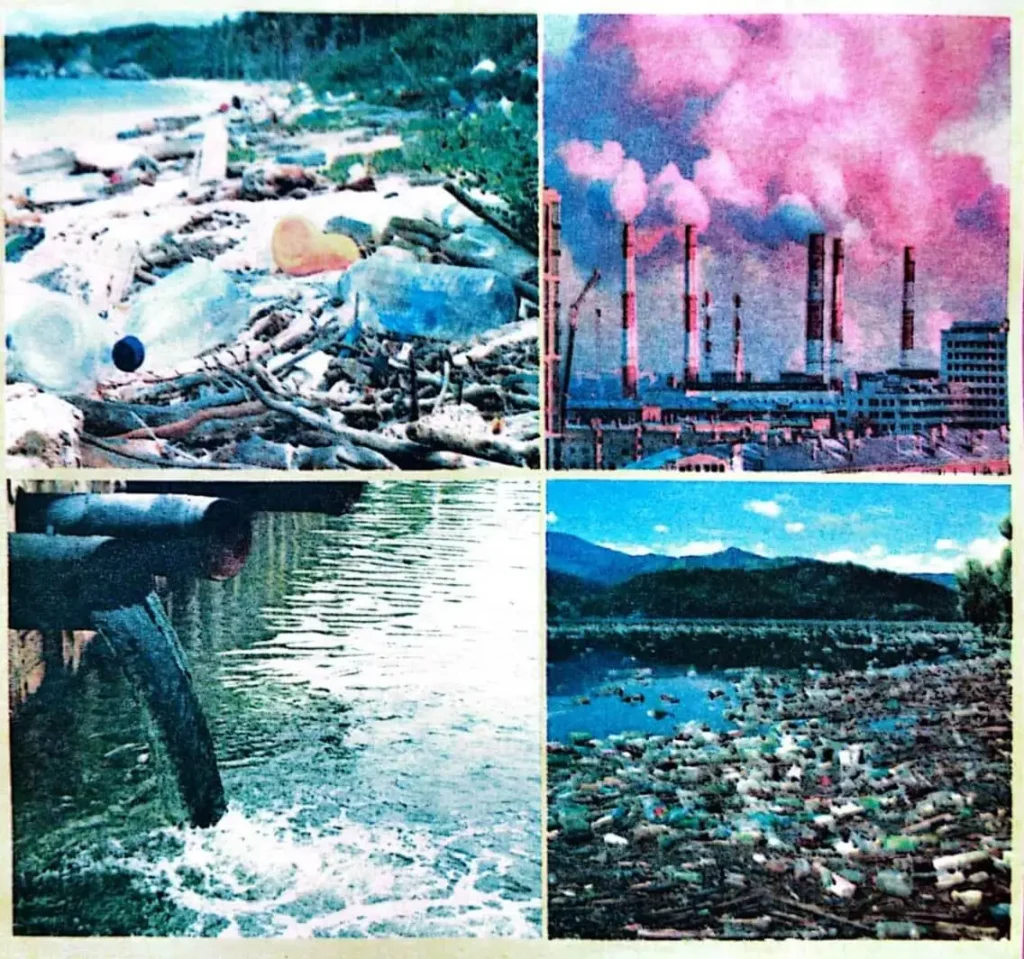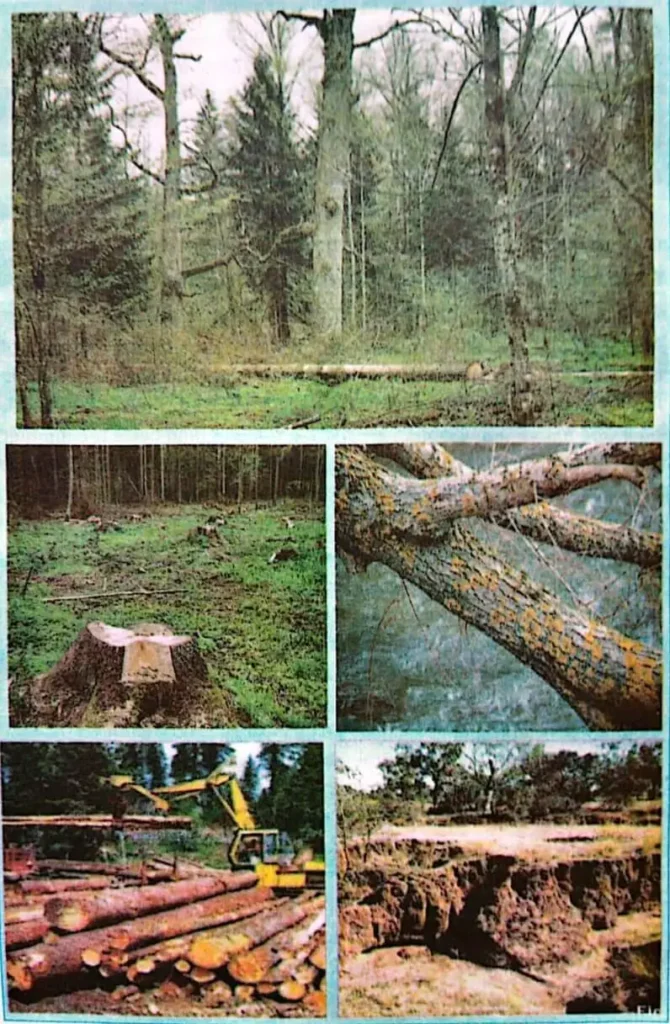8th Class English Notes (Unit-3.1) Pollution
This is Text-1 of chapter #3 “Environment” in the 8th class English book. It provides students with 8th Class English Notes of Unit-3.1 titled “Pollution”
In this complete guide and key book, you get solved exercises of the 8th class English textbook (new edition) of Federal Board (FBISE) and all education boards of Khyber Pakhtunkhwa (KPK).
8th Class English Notes (Unit-3.1) Pollution
Exercise
Do the following tasks:
- Look at the pictures below.
- Can you describe what is happening in the pictures?
- Pair up and discuss the scenario in each picture.

Description of Images
- Top Left Picture: The beach is covered with plastic trash, which is bad for sea animals and the environment.
- Top Right Picture: Factories are releasing a lot of smoke into the air, which is bad for the air we breathe.
- Bottom Left Picture: Dirty water is coming out of a pipe and going into a river or lake, making the water dirty.
- Bottom Right Picture: There is a lot of trash floating in a river or lake, making the water very dirty.
There are different scenarios in these pictures. Together, they show different types of pollution: plastic pollution, air pollution, and water pollution.
As we know, pollution is harmful to animals, plants, and people. It can make animals sick, damage natural places, and make the air and water unsafe.
Therefore, to help the environment, we can use less plastic, make sure factories reduce smoke, and clean water before it goes back into rivers and lakes.
Exercise
Work in groups, look at the pictures given below, and discuss:
- What can you say about the pictures?
- Do you think cutting trees affects the environment?
- Why is a clean environment important to us?

1. What can you say about the pictures?
Answer: Here is my objective description of the above pictures. Yours can be different.
Top Image:
Here, we see a forest with many trees, but one big tree has been cut down and is lying on the ground. Cutting down trees like this adds more carbon dioxide to the air, which increases pollution. Trees help clean the air, so when they are removed, pollution gets worse.
Middle Left Image:
This close-up of a tree stump shows that a tree has been cut down. When many trees are cut down, it leads to the loss of homes for many animals and plants. It also makes the soil weak, which can cause it to wash away easily and pollute rivers and streams.
Middle Right Image:
This close-up of a tree trunk that has been cut shows the details of the bark and branches that are gone. Cutting trees and using big machines to move them creates noise and air pollution. The machines burn fuel and release harmful gases into the air.
Bottom Left Image:
Here, we see heavy machinery, like a yellow excavator, moving logs. The logs are stacked in piles, showing that many trees have been cut down. Using these machines also adds to air pollution because they release harmful gases.
Bottom Right Image:
This image shows land that has been badly eroded. The soil looks dry and has deep cuts, showing that it has been washed away. This happens because there are no trees to hold the soil together. When soil erodes, it can end up in rivers and lakes, making the water dirty and harming fish and other water life.
2. Do you think cutting trees affects the environment?
Answer: Yes, cutting trees affects the environment in many ways. It destroys the homes of animals, increases air pollution by releasing more carbon dioxide, and causes soil erosion. It also contributes to climate change by adding more greenhouse gases to the atmosphere.
3. Why is a clean environment important to us?
Answer: A clean environment is important because it provides us with fresh air to breathe, clean water to drink, and healthy soil to grow food. It also supports a wide variety of plants and animals, which helps maintain a balanced ecosystem.
A healthy environment is essential for our overall well-being and the health of the planet.
Urdu Translation of Unit #3.1 Pollution
مجھے آلودگی سے نفرت ہے۔ یہ مجھے واقعی غصہ دلاتی ہے۔ میں سمجھتا ہوں کہ آلودگی لالچ ہے۔ لوگ ماحول کی پرواہ نہیں کرتے، اس لئے وہ ہوا کو آلودہ کرتے ہیں صرف زیادہ پیسے کمانے کے لئے۔
بڑی کمپنیاں بدترین ہیں۔ وہ جعلی بیانیہ دیتی ہیں کہ وہ ماحول کو آلودہ نہیں کر رہے ہیں۔ ان کے پاس پیسہ ہے کہ وہ “ہرا” کہہ سکیں۔
آلودگی ہم سب پر اثر انداز ہوتی ہے۔ ہم سب کم صحتمند ہوتے ہیں کیونکہ کارخانے ہوا کو یا ہمارے دریاوں کو آلودہ کرتے ہیں۔ ہر کوئی کو سوچنا چاہیے کہ ہم آلودگی کی مقدار کو کیسے کم کرسکتے ہیں۔
جب ہم چل سکتے ہوں تو گاڑی نہیں استعمال کرنا ایک طریقہ ہے۔ جو لائٹیں ہمیں ضرورت نہیں ہوتیں، انہیں بند کرنا اور ایک اور طریقہ ہے۔ اگر آلودگی مزید بڑھتی رہی تو، ہم سخت ماحولی خطرات کا سامنا کریں گے۔”
Exercise
1. Write the synonyms of the following underlined words and re-write the sentences.
a) I hate pollution.
b) It makes me really angry.
c) I think pollution is greed.
d) People don’t care about the environment so they pollute the air just to make lots of money.
e) Big companies are the worst.
f) They pretend they’re not polluting.
g) Pollution affects us all.
h) We are all less healthy because of companies that pollute the air or our rivers.
i) Everybody needs to think about how we can reduce the amount of pollution we create.
j) Turning off lights we don’t need is another.
Synonyms of the Underlined Words
- Hate: dislike, detest
- Angry: furious, enraged, annoyed
- Greed: selfishness, avarice
- Pollute: contaminate, dirty
- Big: large, huge
- Pretend: act, make as if
- Affects: impacts, influences
- Less: reduced, slight, not so much
- Reduce: lessen, lower, decrease
- Need: require, necessitate
Rewritten Sentences
a) I detest pollution.
b) It makes me furious.
c) I think pollution is selfishness.
d) Individuals disregard the environment so they contaminate the air solely for monetary gain.
e) Large corporations are the most egregious.
f) They make as if they’re not polluting.
g) Pollution impacts us all.
h) We are all not so much healthy because of corporations that contaminate the air or our rivers.
i) Everybody needs to contemplate how we can decrease the amount of pollution we generate.
j) Turning off lights we don’t require is another.
Exercise
A – Answer the Following Questions.
1. Describe the feelings expressed by the speaker.
Answer: The speaker expresses strong negative feelings about pollution. He/She feels angry and frustrated because they believes pollution is harming the environment and people’s health.
2. What word was used to describe pollution?
Answer: The word “pollution” was used to describe contamination, impurity, or defilement of the environment.
3. What claims are the big companies making about pollution?
Answer: Big companies claim that they are not polluting the environment or that they are environmentally friendly (“green”) despite evidence suggesting otherwise. They use their wealth to create this image.
4. List down the suggestions made by the speaker to reduce the amount of pollution we create.
Answer: The speaker suggests several ways to reduce pollution: not using cars when walking is possible, turning off unnecessary lights, and overall, thinking about how everyone can collectively reduce the amount of pollution they create.
5. What are other ways in which you can reduce pollution in your daily life?
Answer: Other ways to reduce pollution in daily life include:
- using public transportation or carpooling,
- reducing water usage,
- recycling and reusing materials,
- conserving energy by unplugging electronics when not in use,
- planting trees, and
- supporting eco-friendly products and companies.
Exercise
1 – Re-write each phrase using contraction and use it in sentences.
| Original Phrase | Contractions | Example Sentence |
|---|---|---|
| a) I will | I’ll | I’ll reuse the box from now onwards. |
| b) is not | isn’t | That idea isn’t feasible. |
| c) They are | they’re | They’re going to the concert tonight. |
| d) You are | you’re | You’re going to love this movie. |
| e) He will | he’ll | He’ll arrive at the airport by noon. |
| f) They are | they’re | They’re planning a trip to Europe next summer. |
| g) Should not | shouldn’t | You shouldn’t eat too much junk food. |
| h) Would not | wouldn’t | I wouldn’t go out without an umbrella on a rainy day. |
| i) Will not | won’t | She won’t be able to attend the meeting tomorrow. |
| j) Should have | should’ve | You should’ve called me before coming over. |
| k) We will | we’ll | We’ll meet you at the restaurant at 7 PM. |
Exercise
Character Sketch:
Your task is to write a character sketch of Mother Teresa. She was a famous humanitarian. The steps below will guide you as you write the description. You can also research about her work and achievements.
Steps to write a character sketch
1. Focus on specific features of a character’s appearance and leave the readers to infer what their appearance suggest about the characters.
2. Divide your description into four paragraphs. Each paragraph should touch on something different about the character. For example, in first paragraph, describe the character’s appearance.
In the second paragraph, focus on her work and in the third one, talk about her achievements. In the last paragraph, you can talk about the message she has given to promote peace in the world.
Character Sketch of Mother Teresa
Mother Teresa was a small, gentle woman who looked very calm and peaceful. She had kind eyes and hands that had worked hard for many years. She always wore a simple white and blue saree, which showed her dedication to helping others. People could see just by looking at her that she cared deeply for everyone she met.
She spent her life helping poor and sick people. Mother Teresa started an organization called the Missionaries of Charity. They provided food, shelter, and care for people who had no one else to turn to. She worked hard in the slums of Kolkata and in many other places around the world, showing love and compassion to those who needed it most.
Mother Teresa achieved many great things during her lifetime. She became famous all over the world for her work, and she even won the Nobel Peace Prize in 1979. But what mattered most to her was the difference she made in people’s lives. She showed that even small acts of kindness could change the world for the better.
Mother Teresa had a simple but powerful message: peace and love for everyone. She believed that helping others and spreading love was the key to happiness. Her life showed us that no matter who we are or where we come from, we can all make a difference by caring for each other. Her message of love continues to inspire people to work towards a more peaceful and caring world.
Conclusion
These are 8th Class English Notes of Unit-3.1 titled “Pollution” This sub-unit of chapter number 3 “Environment” is an attempt to make the students aware of how essential it is to have a clean environments around us.
But unfortunately, ever growing human needs, and industrialization keeps on deteriorating the health of environment. And thus, it is posing threats to the biodiversity on earth.
Here, this unit particularly seeks to teach students skills and give them knowledge through a different angle. It correlates their understanding of what is good for us, and how they can use these concepts to practice skills like writing a news report, etc.
We have tried to make the best English notes for 8th class for learners in all across the country. After reading these English notes, students can have a better understanding of the topic and the theme of this lesson.
However, despite our efforts, there can occur typos and mistakes. In that case, we kindly urge you to help us out.
So, please drop your feedback in the comment box below. It helps us improve more and bring forth for you the best English notes.
Regards.








In writing portion you uploaded the character sketch of mother Teresa which has already been done in previous chapter. here in this chapter it is required to write a report on what you think will happen to planet earth if nobody cares about the negative impacts of pollution on our lives.
furthermore, i prepare my lecture from your notes, I find it very helpful and detailed.
Thanks for sharing.